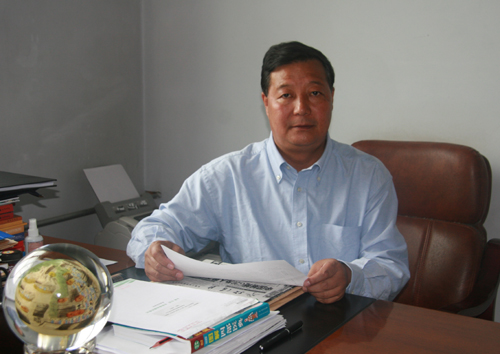
Ao Tsokchen, board chairman of Arura Tibetan Medicine Group in northwest China's Qinghai Province, has been devoted to Tibetan medicine culture preservation, photo from CRIENGLISH.com.
Tibetan medicine has been strange to most Chinese people living beyond the Qingzang Plateau, as the remote area in China's northwest was kept separated from the outside world for a long time due to inconvenient road traffic. In recent years, although Tibetan medicine practice and research have experienced a boom, it is still a mystery to many mainland people.
Ao Tsokchen, board chairman of Arura Tibetan Medicine Group in Qinghai Province, said his group sells 98 percent of the medical products to the mainland as traditional medicine has gradually gained nationwide popularity.
However, Ao said that they still feel pressure during the promotion because people know little about the ancient medicine system, which is an important part of the Chinese medical tradition and has been evolving for nearly 3,000 years. He said many are afraid of trying the products which are usually made up of rarely-seen herbs and minerals.
"As an ancient medical system, Tibetan medicine has been slow in spreading. The main reasons lie in the cultural differences and language barrier." Ao, also a doctor of Tibetan nationality, said that he plans to promote the medicine culture before sales.
Now his culture promotion project is underway as he plans to open up to 200 Tibetan medicine stores across the country by the end of next year. These stores do not only sell medicines, they also aim to acquaint people with the evolving history of Tibetan medicine. Besides, the showcased botanic and animal specimens allow people to know more about the medical materials which are grown in high-altitude areas.
Fifty-four-year-old Ao has actually devoted himself to preserving the Tibetan medical culture for many years.
"We have spent more than 20 years searching for, keeping and publishing the ancient Tibetan medical books, most of which were lost as the centuries passed. Our research found that there once existed at least 4,000 volumes of books, and now we have collected more than 2,000 of them."
Ao told that some of the books were previously scattered among local Tibetan people, and some were kept at local temples.
His research team of around 40 people will continue to retrieve the rest of the books from abroad. "It will take us more time, but we will do everything possible," he added.
Several years ago, Ao Tsokchen proposed to set up a museum for Tibetan medical culture when he found that there is no single museum for the local medicine which boasts a history of thousands of years.
"We made an investigation into the industry and knew that Tibetan medicine is based upon its long history and broad culture. It is a great pity if there is no museum to present the precious culture to people," Ao Tsokchen said.
Taking up 12,000 square meters and costing 120 million yuan (17.7 million U.S. dollars), the museum boasted over 2,000 botanic and animal specimens, 80 wall maps, 1,000 books and 180 surgical appliances from 1,300 years old of history when it opened four years ago.
Last year, the first and only museum for Tibetan medicine in the world attracted more than 100,000 visitors, including foreign delegates who are interested in Tibetan culture.
Now no one will deny that the museum has been a success, but when Ao Tsokchen first presented the proposal of building a non-profit museum, he was confronted with many pressures.
"Many doubted that a museum could earn us profits or something meaningful. Some said it would be better to invest the money into the group's affiliated hospital so that we could make money quickly," Ao recalled, saying he insisted that it was worthwhile to erect the museum. "Even if we did not do it, other people in China would do. Or even some foreigners would consider it."
